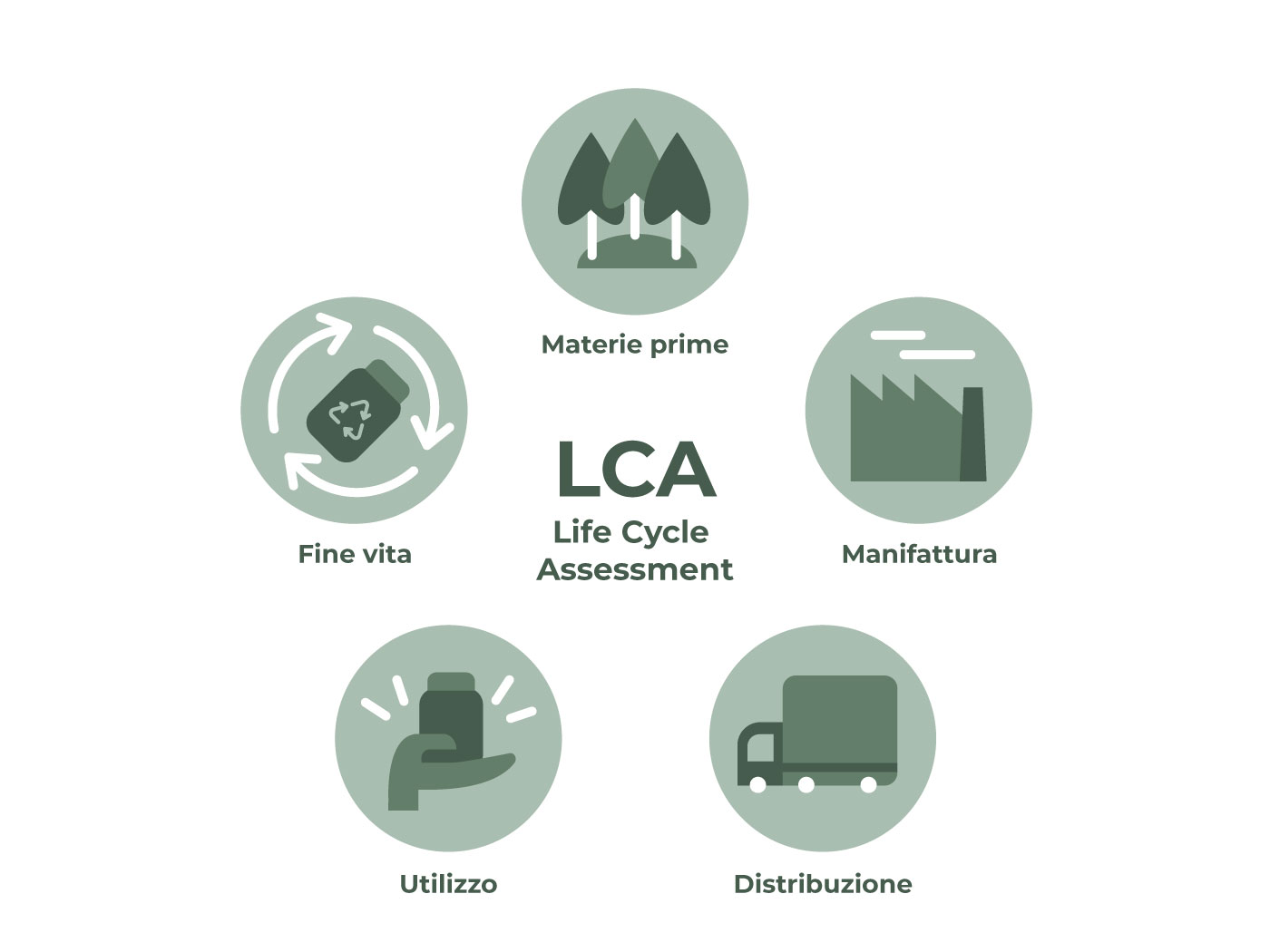The LCA, or Life Cycle Assessment, is a methodology that helps companies integrate environmental sustainability into their business model. Specifically, it is a structured and standardized international method that allows the quantification of the potential impacts on the environment and human health associated with goods and services. For this reason, it is among the main tools used in the field of ecodesign.
Life-Cycle Assessment thus provides the necessary elements to intervene on the major sources of impact and make decisions that allow them to effectively contribute to easing the ecological crisis. And, consequently, to the general transition of society towards circular economy paradigms.
The LCA methodology also allows companies to align with current consumption trends, based on the search for sustainable products and services. Additionally, the return in terms of image and partnerships is significant. In fact, institutions are also paying more attention to sustainability, to the point that they seek to integrate LCA themselves. integrate LCA themselves.
Happy reading! (PS: In paragraph 7, we’ve summarized the advantages of LCA)
1. Definition of LCA: What is Life Cycle Assessment
Life Cycle Assessment (LCA) or life cycle analysis is a structured and internationally standardized method. The LCA methodology is based on analyzing the life cycle of products and services to identify their negative effects on the environment.
Through this approach, potential impacts on the environment and human health associated with a good or service generated in all phases of existence are identified, namely:
- the extraction of raw materials and their processing;
- the production of the product and its distribution;
- the use of the product;
- its end-of-life (disposal or, with more sustainable solutions in mind, recycling and reuse).
LCA not only allows for the identification but also the quantification of environmental impacts over the life cycle of products and services. The comprehensive measurement provides the extent of their environmental footprint based on the selected impact categories (related to inputs and outputs) relevant to the object of the study.

LCA: Measure and Improve Environmental Impact
To find out how we can assist you with Life Cycle Analysis (LCA) calculations, contact us for a free consultation.
2. Life Cycle Assessment and Sustainability
The Life-Cycle Assessment methodology allows for the creation of better products and services from the standpoint of environmental sustainability. For companies, it is a fundamental tool for designing or redesigning their offerings in this way. They can reduce waste, pollution, and waste by knowing exactly where to act.
However, this alone is not enough for companies to fully develop toward sustainability in all its dimensions. They must equip themselves with other tools to help them fully achieve this goal. Among these:
- S-LCA analysis (Social Life Cycle Assessment) in the field of social sustainability;
- LCC analysis (Life Cycle Costing) in the field of economic sustainability.
3. How to Perform LCA Analysis, the 4 Steps of the Methodology
Analyses conducted through the LCA methodology are carried out through a procedure made up of four fundamental steps.
- The first phase is the definition of the goal and scope. Here, the prerogatives of the study are specified in terms of objectives and uses, type of analysis, and planning. The functional unit (the reference unit for each collected and processed datum) and the system boundaries (phases and processes to be included in the analysis) are also identified for study. Finally, the data to be collected and their attributes are identified for conducting the analyses.
- The second stage is the inventory analysis, which aims to describe and measure the inflows and outflows within the pre-determined system boundaries defined in the goal setting phase. To do this, flowcharts are used to represent the life cycle. This is followed by data collection and organization into inventory tables.
- Then, there is the impact assessment. In this phase of the life cycle analysis, the impacts on the environment related to the identified flows are associated based on reference categories.
- Finally, interpretation. This phase is conducted simultaneously with the others to better guide the entire study. At this step, results are evaluated to identify and elaborate on the most significant ones based on the primary purpose. This concerns the environmental impacts generated in the life cycle of products and services and the solutions to contain, reduce, and/or compensate for them.


4. What Are the Main Reference Standards for LCA Analysis?
Life Cycle Assessment analyses are based on some ISO standards that determine the procedure for their realization. These standards are part of the ISO 14000 series, which companies can adhere to on their own initiative. In general, the standards in this series concern the ways in which companies can intervene in their environmental impacts to reduce them.
Specifically, two related ISO standards are currently in force:
- UNI EN ISO 14040:2021 (titled “Environmental management – Life cycle assessment – Principles and framework”);
- UNI EN ISO 14044:2021 (titled “Environmental management – Life cycle assessment – Requirements and guidelines”).
5. What is LCA Used For?
Life cycle assessment allows companies to gain an overall picture of the environmental impacts generated by the production and distribution of their products and services. In this regard, they can then move on to defining and implementing the necessary measures to control, minimize, and/or compensate for them. For example, selecting less impactful materials and production approaches among the options based on LCA studies and in line with ecodesign.
Life Cycle Assessment is a time and money-consuming approach, requiring the collection of appropriate data and the analysis of large datasets. Nevertheless, more and more companies are opting to use it because it provides valuable information and, combined with insights from other methods, allows for more informed decision-making and more effective strategies.
6. The Importance of LCA for Businesses
Life Cycle Assessment can support various development processes for companies, in addition to providing life cycle analyses for products and services. This is true both in the creation of goods with a lower environmental impact during their existence and across different corporate functions. For example, at the strategic level, it can guide companies in their investments in technology and innovations for production.
Additionally, LCA allows for obtaining reliable information on the impacts of products and services that can also be used for communication activities. The use of real and truthful data is even more crucial with the approval of the European Council’s Corporate Sustainability Reporting Directive (CSRD) in November 2022. With this directive, companies face more scrutiny over the truthfulness of their claims about their environmental impact to prevent greenwashing.

7. The Advantages of Life Cycle Assessment
Life-cycle assessment offers companies several advantages. In particular, in addition to life cycle analysis of products and services, this methodology allows companies to:
- communicate more accurately and reliably the main qualities of products, services, and production processes in terms of environmental performance to their stakeholders;
- optimize processes in terms of cost management and gain competitive advantages from a truly sustainable offering;
- demonstrate their commitment in this area through the recognition of environmental labels and certifications.
Through an LCA analysis, you can achieve high-value results to start your company’s journey toward environmental sustainability. If this is the direction you are planning for your business, we at HENRY & CO can help you develop your LCA study, evaluating the variables of your case and providing you with the information you need to improve your performance and offering!
LCA: Measure and Improve Environmental Impact
To find out how we can assist you with Life Cycle Analysis (LCA) calculations, contact us for a free consultation.
